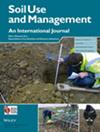添加生物碳对土壤动物群落的影响--荟萃分析
IF 3.7
3区 农林科学
Q1 SOIL SCIENCE
引用次数: 0
摘要
土壤动物群是全球生物多样性的重要组成部分,在生态系统中发挥着至关重要的作用。土壤动物中的微生物群落可对土壤肥力产生重大影响,因为微生物群落通过支持生态完整性和农业生产力,在土壤功能中发挥着关键作用。本研究评估了生物炭对土壤动物群落的影响以及微生物群落的反应。生物炭是一种高孔隙度的有机碳材料,生物炭对土壤动物中微生物群落的影响尚不清楚。迄今为止,尚未对生物炭对土壤动物中微生物群落的影响进行定量或全面调查。在本文中,我们通过对 24 项研究和 459 项观察结果进行荟萃分析,旨在量化生物炭对不同环境下土壤动物群落丰度和多样性的影响。生物炭对土壤动物群落的影响是通过分析土壤动物的反应来确定的,其中包括生物炭原料、pH 值和热解、施用率和施用时间的差异,以及具有不同生理特征(体型、是否有外骨骼)的土壤动物。结果表明,生物炭对土壤动物群落的影响为中性(不显著),总平均效应大小(Hedge's g)=-0.04(CI:-0.28;-0.20)。结果 使用 Egger 回归法进行数据验证,结果显示无发表偏差。pH 值较高的生物炭和传统热解产生的生物炭对土壤动物有益,但不显著(QM (df = 3) = 4.07, p = .25)。此外,土壤动物的体型显著反映了对生物炭应用的不同敏感度,中等体型的动物从生物炭添加中获益最多(0.35;CI:0.05;0.65;n = 6;56)。有外骨骼动物(n = 11;125)和无外骨骼动物(n = 17;308)也分别对添加生物炭表现出有利和不利的反应。这项研究可为生物炭土壤改良过程中动物群落的演化模式提供基础数据,并为全面评估生物炭的环境和生物效应提供信息。本文章由计算机程序翻译,如有差异,请以英文原文为准。
Effects of biochar addition on soil fauna communities—A meta‐analysis
Soil fauna is an important part of global biodiversity and plays a vital role in ecosystems. The microbial communities in soil fauna can have significant impacts on soil fertility, as microbial communities play a pivotal role in soil function by supporting ecological integrity and agricultural productivity. This study assesses the effect of biochar on soil fauna and response of microbial communities. Biochar is a highly porous organic carbon material, and the impact of biochar on microbial communities in soil fauna remains unclear. To date, no quantitative or comprehensive investigation has been undertaken to examine the effects of biochar on microbial communities in soil fauna. In this paper, we aim to quantify the effects of biochar on the abundance and diversity of soil fauna communities in various environments by conducting a meta‐analysis of 24 studies and analysing 459 observations. The impact of biochar on soil fauna communities was determined by analysing the responses of soil fauna that included differences in biochar feedstock, pH and pyrolysis, application rates and application times, as well as soil fauna with different physiological characteristics (body size, presence of exoskeletons). The results showed that biochar had a neutral (non‐significant) effect on the soil fauna community, with a total mean effect size (Hedge's g ) = −0.04 (CI: −0.28; −0.20). Results Data validation using Egger regression showed no publication bias. Higher pH biochar and biochar from conventional pyrolysis were beneficial to soil fauna, but not significant (QM (df = 3) = 4.07, p = .25). In addition, body size of soil animals significantly reflected different sensitivities to biochar application, with Medium‐sized animals benefiting the most from biochar addition (0.35; CI: 0.05; 0.65; n = 6; 56). Animals with (n = 11; 125) and without exoskeletons (n = 17; 308) also showed favourable and unfavourable responses to biochar addition, respectively. This study can provide basic data for the evolutionary pattern of animal communities during biochar soil amendment, as well as information for the comprehensive evaluation of the environmental and biological effects of biochar.
求助全文
通过发布文献求助,成功后即可免费获取论文全文。
去求助
来源期刊

Soil Use and Management
农林科学-土壤科学
CiteScore
7.70
自引率
13.20%
发文量
78
审稿时长
3 months
期刊介绍:
Soil Use and Management publishes in soil science, earth and environmental science, agricultural science, and engineering fields. The submitted papers should consider the underlying mechanisms governing the natural and anthropogenic processes which affect soil systems, and should inform policy makers and/or practitioners on the sustainable use and management of soil resources. Interdisciplinary studies, e.g. linking soil with climate change, biodiversity, global health, and the UN’s sustainable development goals, with strong novelty, wide implications, and unexpected outcomes are welcomed.
 求助内容:
求助内容: 应助结果提醒方式:
应助结果提醒方式:


